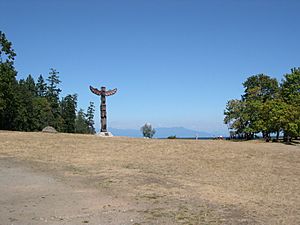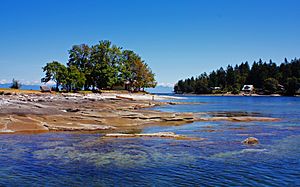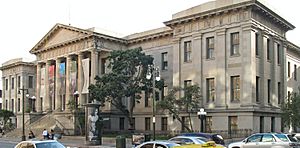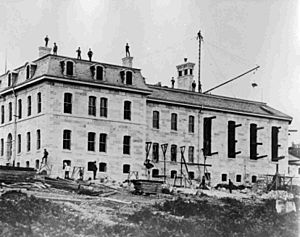Newcastle Island Marine Provincial Park facts for kids
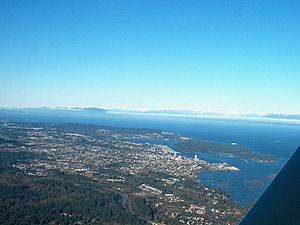
Newcastle Island (Saysutshun) is a beautiful provincial park. It is on a small island near Nanaimo, British Columbia, Canada. This island has a rich history and is now a popular spot for outdoor fun.
Contents
A Journey Through Time: Newcastle Island's History
Newcastle Island has a long and interesting past. It changed from a seasonal fishing spot for the Coast Salish people to a busy industrial hub. Today, it is a peaceful marine park.
First Peoples: Living on Saysutshun
Long ago, the Snuneymuxw First Nation, part of the Coast Salish group, lived on Newcastle Island. They had two villages called Saysetsen and Clotsun. Saysetsen was on the east side of the island. It was perfect for catching herring, a type of fish, in late winter and early spring.
The Snuneymuxw people used special hardwood sticks with sharp whalebone teeth to catch herring. They could catch many fish quickly. They lived on Newcastle Island from January to April. Then, they would move to other islands to fish for salmon. They followed the fish seasons, always returning to Newcastle Island by January.
The Discovery of Coal: A New Era Begins
In 1849, coal was found on Newcastle Island. This was a big deal because coal was very important for steamships. The island was named after Newcastle upon Tyne in England, which was also famous for coal.
A Snuneymuxw man named Ki’et’sa’kun first told Europeans about the coal. He showed them where to find it. Because of his discovery, he was called Coal Tyee, meaning "Great Coal Chief." Soon, coal mining became a major industry in Nanaimo.
Two main mines operated on Newcastle Island: the Fitzwilliam and the Newcastle mines. These mines dug tunnels that even went under the sea to nearby islands. Miners worked hard, and sometimes, sadly, accidents happened. For example, a gas explosion in the Fitzwilliam Mine in 1876 caused three deaths.
Strong Stone: Sandstone Quarrying
Besides coal, Newcastle Island also had excellent sandstone. This strong, beautiful stone was used for building. In 1869, a company from the United States Mint in San Francisco chose Newcastle sandstone for their new building. The stone was very durable and survived two major earthquakes!
Many other important buildings were also made with Newcastle sandstone. These include the BC Penitentiary, the Nanaimo Post Office, and the Nanaimo Court House.
The island's sandstone was also used to make "pulp-stones." These were big grinding stones that helped turn wood into pulp for making paper. This business was successful until artificial stones became cheaper and lasted longer.
Fishing and Shipyards: Herring Salteries
In the early 1900s, many Japanese families ran herring salteries on Newcastle Island. They salted herring and salmon to sell to countries like Japan, Hong Kong, and China. They used a special fishing method called seining, where two boats would surround a school of fish with a net.
Some of these salteries burned down in 1912 but were quickly rebuilt. Later, a company called Nanaimo Shipyards Limited started on the island. They built and repaired ships. However, during World War II in 1941, Japanese-Canadians were forced to leave their homes and businesses. This included the saltery owners and the shipyard.
A Fun Getaway: The CPR Resort
The Canadian Pacific Railway (CPR) bought Newcastle Island in 1930. They wanted to create a fun island resort for day trips and vacations. They spent a lot of money building a pavilion with a dance floor, picnic areas, and a bathhouse. They even brought muskrats and beavers for visitors to see!
Old steamships, like the Charmer and the Princess Victoria, were used as "floating hotels" where people could stay for a week. These ships also brought many visitors from Vancouver to the island. The resort was very popular, with thousands of visitors each season. But when World War II started, the Princess ships were needed for the war, and the resort closed.
The pavilion from the CPR resort is still on the island today. It was restored in 1984 and is a reminder of the island's resort days.
Becoming a Park: Nanaimo and Provincial Ownership
After the war, the CPR sold Newcastle Island to the City of Nanaimo in 1955. However, the city found it hard to pay for the island's upkeep. So, in 1959, the people of Nanaimo voted to sell the island to the BC Government. They wanted it to become a provincial park.
The government agreed to several conditions. These included making the island a marine park and developing it quickly. Newcastle Island officially became a Class A provincial park in 1960. It was hoped it would become the "gem of Vancouver Island" and a place for everyone to enjoy nature and history.
Newcastle Island Today: What to Do
Today, Newcastle Island is a peaceful place. Only park staff live there. It is a very popular spot for tourists and locals.
You can enjoy many activities on the island:
- Hiking: Explore the many trails that wind through the island's forests.
- Camping: There are walk-in campsites available for overnight stays.
- Bird Watching: Look for different kinds of birds, especially around Mallard Lake.
- Kayaking and Boating: Many people visit by kayak or boat. You can anchor or use mooring buoys.
Getting There: Transportation to the Island
Newcastle Island (Saysutshun) can only be reached by water. A small ferry for foot passengers runs from Maffeo Sutton Park in downtown Nanaimo. The ride takes about ten minutes. It is also a favorite destination for kayakers and other boaters. Sometimes, at very low tide in the summer, you can even walk across to Protection Island.
Mallard Lake: A Wildlife Haven
Mallard Lake is in the middle of the island. It is an artificial lake that was once a reservoir for the people living on the island. Now, it is a peaceful wildlife sanctuary. It is a great place for bird watching. Cars are not allowed on the island, keeping it quiet and natural.
Images for kids


